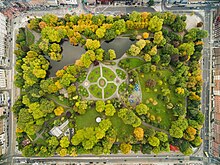User:Kith98/sandbox

Economical Impact
[edit]The development and evolution of Inwood Park's flora and fauna are intrinsically linked to the financial stability of New York City and its residents. A deeper understanding can support the evolution and Inwood development. The fiscal endeavors of the state have some impact on the [1]health and species diversity of flora and fauna in New York city parks. During the New York Fiscal crisis in the 1970s, the New York state government decided it would be prudent to cut funding for the maintenance of New York parks and redistribute the money to other areas of public and private services[2]. Consequently, many public workers in New York City parks were laid off due to this decision. It is fortunate that the Protected Native Plants Program was created in 1989 and that other regulations have been adopted since then.
One of the proposals that was on the ballot at the November 2022 general election in the state of New York was the Clean Water, Clean Air, and Green Jobs Environmental Bond Act[3], which was one of several proposals on the ballot. There was a majority vote in favor of passing this bill. It is expected that the New York city government will set aside an incredible 4.2 billion dollars in order to enhance, allocate and redevelop the natural landscape and environment of the state in the near future. In order to realize the full potential of this program, it is estimated that 650 million of this money will be allocated to the open spaces (parks) and agricultural lands of New York City. This would entail buying land to make into conservations, restoration/beautification of parks, and expanding New York state land. It is expected that the Clean Air, Water, and Green Jobs Environmental Bond Act will result in the creation of approximately 84,000 jobs as a result of this legislation[3]. A training program designed to provide employees with an understanding of the environment will be provided by the Parks Opportunities Program for six to nine months. A typical employee's curriculum would include learning about soil contents, tree types, and species living in the area. It is pertinent to note that the flora and fauna of Inwood Park may be adversely affected by the training.
The state of New York mainly uses public funds as a means of funding the provision of public services that are available to the general public. There are three categories to consider. Neostatism, neo-corporatism, and neo-communitarianism. A majority of Inwood Hill Park's funding is currently provided by a combination of grants and property taxes, which are common methods of funding parks in low-income areas. Partnerships for parks area nonprofit organization that has partnered with the city of New York to maintain and manage parks and topromote their use out acrossthe city. The organization is dedicated to the maintenance and use of parks throughout the city. It should also be noted that some other parks in New York have received significant funding from events held there, such as Bryant Park. In the case of Central Park, it receives a substantial amount of funding from local residents in the form of donations made to the park by the residents themselves.
References
[edit]- ^ Scimecca, James (2022-10-18). "Can New York Afford the "Clean Water, Clean Air and Green Jobs Environmental Bond Act of 2022"?". Empire Center for Public Policy. Retrieved 2022-11-22.
- ^ Krinsky, John; Simonet, Maud (2017). Who Cleans the Park?: Public Work and Urban Governance in New York City. University of Chicago Press. doi:10.7208/chicago/9780226435619.003.0004. ISBN 978-0-226-43558-9.
- ^ a b "New York Voters Pass Historic 2022 Environmental Bond Act". Environmental Defense Fund. Retrieved 2022-11-22.
 | This is a user sandbox of Kith98. You can use it for testing or practicing edits. This is not the sandbox where you should draft your assigned article for a dashboard.wikiedu.org course. To find the right sandbox for your assignment, visit your Dashboard course page and follow the Sandbox Draft link for your assigned article in the My Articles section. |
